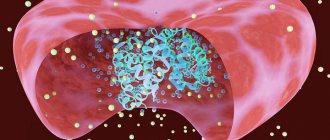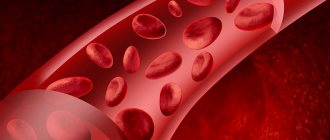What may affect the results
Glycated hemoglobin test results may be inconsistent in patients with hemoglobinopathy, including sickle cell disease, pregnancy (second and third trimesters) and the puerperium, HIV, recent bleeding or transfusion, erythropoietin therapy, and patients on hemodialysis. reflect the true glucose content.
Only plasma glucose criteria should be used to diagnose diabetes in these situations. Interpretation of the result may be complicated by the presence of variant forms of hemoglobin: hemoglobin A2, which increases in beta thalassemia (a genetic disease), and fetal hemoglobin (fetal hemoglobin), which remains high until 6 months after birth.
How to maintain normal glycated hemoglobin?
In order for the level of glycated hemoglobin to remain normal, it is important to pay attention to lifestyle and nutrition.
“To maintain this indicator in the normal range, first of all, it is necessary to follow the general principles of a healthy lifestyle (rational nutrition, physical activity), explains Danil Khaziev, general practitioner at the ELISA Medical Center. — If you already have a carbohydrate metabolism disorder, you need to regularly take medications as part of the therapy prescribed by your doctor.
If glycated hemoglobin is at the upper limits or exceeds the norm, then it is recommended to consult a nutritionist, endocrinologist or therapist to draw up an individual nutrition plan with a limitation of easily digestible carbohydrates. It is also necessary to increase the amount of physical activity. This will help prevent the development of type 2 diabetes.
Reference values are presented in the table
| Glycated hemoglobin, % | Interpretation |
| < 6,0 | normal level |
| ≥ 6,5 | diagnostic criterion for diabetes mellitus |
| 6,0 – 6,5 (5,7 – 6,4) | increased risk of developing diabetes and its complications according to WHO (according to ADA, American Diabetes Association) |
Hemoglobin is the oxygen-carrying protein of red blood cells. Depending on the structure there are:
- normal hemoglobin (designated HbA), which makes up 85-95% of total hemoglobin;
- hemoglobin A2 (HbA2), which constitutes less than 3.5% of the total hemoglobin content;
- fetal hemoglobin (HbF) - in an adult it is less than 1%.
Oxygen, joining the hemoglobin found in red blood cells, is delivered to the organs and tissues of the body, where it is needed for their normal functioning.
In various diseases, a chemical change in the structure of hemoglobin occurs. Thus, in diabetes mellitus (a disease associated with impaired absorption of glucose, resulting in the development of hyperglycemia - a persistent increase in blood glucose levels), glucose is added to hemoglobin to form glycated hemoglobin (indicated as HbA1c). And the higher the blood glucose level, the more hemoglobin is modified into glycated hemoglobin.
The formation of glycated hemoglobin is irreversible (that is, glycated hemoglobin cannot return to normal hemoglobin), and its concentration in the blood depends both on the lifespan of red blood cells (up to 120 days) and on the concentration of glucose in the blood. Since the rate of formation of glycated hemoglobin is higher, the higher the level of glucose in the blood, its concentration can be used to judge the average glucose level in the blood over the last 8–12 weeks before the study. Moreover, the content of glycated hemoglobin does not depend on daily and hourly fluctuations in glucose, physical activity and food intake immediately before taking a blood sample.
A glycated hemoglobin test is recommended for all people over 45 years of age for timely assessment of the risk of developing diabetes and its complications (at least once every three years).
If at least one of the risk factors for developing diabetes is present (excess weight, cardiovascular diseases, hypertension (BP ≥ 140/90 mmHg), relatives with diabetes, impaired cholesterol metabolism (HDL (high-density lipoprotein) level) <0.9 mmol/L) or triglyceride levels >2.82 mmol/L), glucose levels should be monitored by testing glycated hemoglobin at least once a year.
For patients diagnosed with diabetes mellitus, glycated hemoglobin concentration testing is recommended to be done every three months to monitor the effectiveness of treatment and assess the risk of complications:
- retinopathy (damage to the retina of the eye, which in severe cases can result in blindness);
- nephropathy (kidney damage);
- polyneuropathy (damage to nerve fibers, which can lead to muscle atrophy (wasting));
- arterial hypertension (high blood pressure);
- atherosclerosis (cholesterol deposits in the walls of blood vessels);
- IHD (coronary heart disease).
What level of HbA1C is considered normal?
The official norms of the indicator are the same for both men and women. It does not depend on age, with minor exceptions.
A glycated hemoglobin level of up to 5.7% is considered normal. The best indicator is 5.5%.
Finding the result in the range of 5.7% -6.4% indicates the risk of developing type II diabetes mellitus. In this case, it is important to take measures to reduce the likelihood of getting sick and consult a doctor. At levels up to 6%, a switch to a low-carbohydrate diet is required.
An indicator of 5.6-5.9% is considered slightly elevated; there are no symptoms of carbohydrate metabolism disorders, but excess weight may be present.
When the HbA1C level is between 6.1-6.4%, some specialists already diagnose pre-diabetes and prescribe treatment. If the development of the disease is left to chance, then within 6-10 years problems with the kidneys, vision and legs will appear. The risk of death from cardiovascular disease in this case increases by 25%. The prediabetic state requires a transition to a healthy lifestyle.
According to the analysis result showing HbA1C more than 6.5%, diabetes mellitus is possible, but additional studies are required to confirm the diagnosis. As a rule, it is confirmed. The figure of 6.5-7.5% indicates a pathology of moderate severity.
For people with diabetes, it is recommended to maintain the rate at a level of up to 7%. However, keeping the figure within 5.5-5.7% will prolong life and help avoid disability.
An indicator of 8% indicates poor control and rapid development of complications, including loss of consciousness and coma.
Establishing and maintaining normal HbA1C is important to reduce the development of dangerous complications:
- Heart attack and stroke.
- Diabetic retinopathy or neuropathy, kidney damage.
In children with diabetes, it is advisable to maintain a glycated hemoglobin level of 5.4% until adolescence. The figure of 4-5.9% indicates that there is no disease. 6-7% - the course of the disease is well controlled. With an indicator of 7.1%, a serious condition is recorded.
Reasons for a decrease in glycated hemoglobin in the blood:
- Hypoglycemia (low blood glucose).
- Normalization of glucose levels in patients with diabetes (effective treatment).
- False underestimation in hemolytic anemia.
- False underestimation after bleeding, blood transfusion (blood transfusion).
Sources:
- Classification and Diagnosis of Diabetes: Standards of Medical Care in Diabetes—2021 American Diabetes Association Diabetes Care Jan 2021, 44 (Supplement 1) S15-S33; DOI:10.2337/dc21-S002
- Cas Weykamp, Ph.D. HbA1c: A Review of Analytical and Clinical Aspects. Ann Lab Med 2013;33:393-400
- Wenjia Guo, Qi Zhou, Yanan Jia, Jiancheng Xu. Increased Levels of Glycated Hemoglobin A1c and Iron Deficiency Anemia: A Review. Med Sci Monit 2021 Nov 7;25:8371-8378.
- Oliver Schnell, J Benjamin Crocker, Jianping Weng. Impact of HbA1c Testing at Point of Care on Diabetes Management. J Diabetes Sci Technol 2021 May;11(3):611-617.
What is HbA1C
The content of the article
HbA1C is hemoglobin (the molecule that carries oxygen in the blood) which contains glucose. Although this process normally occurs through enzymatic action, the type of binding that is responsible for HbA1C is non-enzymatic, and depends only on the glucose level and the time available for binding.
Blood test for HbA1C
HbA1C levels rise along with glucose levels, and thus high HbA1C values indicate that blood glucose levels have been high for the past 3-4 months. In other words, the test shows that the patient has poor diabetes control.
How is the material collected?
The material for the study is venous blood. There is a standard algorithm for collecting venous blood. The patient sits in a chair, takes a comfortable position, places one arm on a special cushion and slightly bends it at the elbow.
The medical worker bandages the arm above the elbow with a special rubber bandage, after placing a cloth napkin under it (protects it from damage).
The skin is then treated with a disinfectant, a needle is inserted and, after obtaining a sufficient amount of blood, the syringe is removed. The puncture site is additionally treated and a cotton swab is applied to it, which must be removed after the bleeding has stopped.
Some medical centers have different blood collection systems. For this purpose, a special vacuum tube is used, which reduces skin trauma and increases the reliability of the study. The sampling technology is practically no different from the traditional method, but instead of a syringe, a vacuum tube is used. Blood can be stored at a temperature of 2 to 8°C. The stability of the sample is maintained for 7 days.
Best materials of the month
- Coronaviruses: SARS-CoV-2 (COVID-19)
- Antibiotics for the prevention and treatment of COVID-19: how effective are they?
- The most common "office" diseases
- Does vodka kill coronavirus?
- How to stay alive on our roads?
The importance of the HbA1C test
Diabetes mellitus is a fatal disease that requires careful treatment to reduce the risk of its many complications. If blood glucose levels are effectively controlled from the time of diagnosis, the patient's long-term outcome will be better, even if control worsens in subsequent years. This means that early diagnosis has the dual benefit of allowing better control of blood glucose levels and contributing to improved patient health.
Monitoring blood glucose levels
The convenience of the HbA1C test means that its use to screen for diabetes may increase patient acceptance of testing. The analysis also makes it possible to compare indicators with the previous survey. All this improves treatment results.
On the other hand, using the HbA1C test for routine testing is more expensive than measuring plasma glucose. But in this case, the usefulness of such an analysis is undeniable.
The main value of the HbA1C test is its ability to reflect blood glucose levels over a specific period, rather than a specific point of testing. This period reflects the lifespan of red blood cells containing hemoglobin, namely 120 days. However, the level also shows recent changes in the HbA1C value, since 50% of HbA1C is formed one month before collection of the test sample, 25% in the previous month. The remaining 25% reflects the remaining early four-month period.
Sources
- Ribeiro de Lima JG., Abud GF., Freitas EC., Bueno Júnior CR. Effects of the COVID-19 pandemic on the global health of women aged 50 to 70 years. // Exp Gerontol - 2021 - Vol150 - NNULL - p.111349; PMID:33892133
- Manaer T., Yu L., Nabi XH., Dilidaxi D., Liu L., Sailike J. The beneficial effects of the composite probiotics from camel milk on glucose and lipid metabolism, liver and renal function and gut microbiota in db/db mice. // BMC Complement Med Ther - 2021 - Vol21 - N1 - p.127; PMID:33888105
- Mani Deepthi D., Vaikkakara S., Patil A., Ganta S., Sachan A., Raghavendra K., Kiranmayi VS., Chowhan AK. Effect of Correction of Hyperthyroidism with Anti-thyroid Drugs on the Glycated Hemoglobin in Non-diabetic Patients with Primary Hyperthyroidism. // Int J Endocrinol Metab - 2021 - Vol19 - N1 - p.e105751; PMID:33815517
- Pohanka M. Glycated Hemoglobin and Methods for Its Point of Care Testing. // Biosensors (Basel) - 2021 - Vol11 - N3 - p.; PMID:33806493
- Hu X., Deng H., Zhang Y., Guo X., Cai M., Ling C., Li K. Efficacy and Safety of a Decision Support Intervention for Basal Insulin Self-Titration Assisted by the Nurse in Outpatients with T2DM: A Randomized Controlled Trial. // Diabetes Metab Syndr Obes - 2021 - Vol14 - NNULL - p.1315-1327; PMID:33790599
- Okamoto T., Shima H., Noma Y., Komatsu M., Azuma H., Miya K., Tashiro M., Inoue T., Masaki C., Tada H., Takamatsu N., Minakuchi J. Hereditary spherocytosis diagnosed with extremely low glycated hemoglobin compared to plasma glucose levels. // Diabetol Int - 2021 - Vol12 - N2 - p.229-233; PMID:33786277
- Mazahery H., Gammon CS., Lawgun D., Conlon CA., Beck KL., von Hurst PR. Pre-diabetes prevalence and associated factors in New Zealand school children: a cross-sectional study. // NZ Med J - 2021 - Vol134 - N1531 - p.76-90; PMID:33767489
- Abbas E., Ahmed Siddiqui I., Khan MS., Perveen K., Butt A., Fawwad A. Fasting Glucagon Level in Type 2 Diabetes and Impaired Glucose Tolerance and Its Association With Diabetes-Associated Clinical Parameters: A Study From Karachi, Pakistan. // Cureus - 2021 - Vol13 - N2 - p.e13430; PMID:33758717
- Alkethiri K., Almtroudi T., Jurays AB., Abanumay F., Aldammas M., AlKhodheer M., Iqbal M., Habib SS., Bashir S. The relationship between type 2 diabetes mellitus with cognitive functions. // Heliyon - 2021 - Vol7 - N3 - p.e06358; PMID:33748460
- Jaber H., Issa K., Eid A., Saleh F.A. The therapeutic effects of adipose-derived mesenchymal stem cells on obesity and its associated diseases in diet-induced obese mice. // Sci Rep - 2021 - Vol11 - N1 - p.6291; PMID:33737713
What do the study results mean?
Depending on the information received, one can judge the state of a person’s carbohydrate metabolism. A result of 4 to 5.7% is considered normal; it indicates normal processes of sugar metabolism, no risk of developing diabetes or other diseases that are accompanied by changes in this indicator.
Deviations above normal:
- From 5.6 to 6%. It means that the disease has not yet developed, but the person has a tendency to disrupt glucose metabolism, is at risk and requires the appointment of preventive measures. In most cases, improving your diet and regular physical activity will be enough to normalize your indicators.
- From 6.1 to 6.4%. Indicates a high degree of risk and requires additional research. They will allow you to identify the degree of activity of the pathological process and select the most effective preventive measures.
- From 6.5 to 7%. Indicates the development of diabetes in the early stages. To clarify the prognosis, additional research methods are prescribed. Then the doctor will prescribe a suitable treatment regimen; after 3-4 months a repeat test for glycohemoglobin will be required.
- Above 7%. A marker for the development of diabetes and serious disorders of glucose metabolism. Requires immediate contact with an endocrinologist to receive adequate therapy and reduce the risk of complications.
An increase in glycated hemoglobin levels does not always indicate the development of diabetes. For example, newborns retain a high level of fetal hemoglobin for some time, which reacts better with glucose. In the first months of life, this test will demonstrate high glycohemoglobin values.
Factors that can provoke an excess of the normal level of glucose-bound hemoglobin also include iron deficiency, removal of the spleen, disturbances in the functioning of the thyroid gland and other endocrine glands. As a result of these pathologies, the processes of red blood cell renewal slow down, which leads to an increase in the amount of hemoglobin associated with sugars, since these compounds are very persistent and can persist for a long time.
Deviations towards a decrease in the amount of glycated hemoglobin may also be observed. Such results are quite rare and may indicate long-term hypoglycemia or renal failure. A sharp decrease in the level of glycohemoglobin is also observed after massive blood loss, internal hemorrhages and serves as a marker of the active functioning of the hematopoietic system. At the same time, the rate of formation of new red blood cells and renewal of hemoglobin in the blood increases significantly, which leads to a decrease in the indicator below normal values.
Conditions that interfere with HbA1C testing
Any condition that increases red blood cell fragility or promotes nonenzymatic glycosylation of hemoglobin without high blood glucose levels can cause false HbA1C test results.
The list of factors that reduce the accuracy of the analysis includes the following conditions:
- Reduced life expectancy of red blood cells in hemolytic anemia, chronic renal failure, severe liver disease and any chronic diseases associated with anemia, vitamin B12 deficiency and folic acid deficiency.
- Regular blood donation. It is also an artificial cause of shortening the lifespan of red blood cells.
In such cases, another diagnostic method, such as fasting plasma glucose measurement, should be used. A discrepancy between two glucose testing methods for diabetes should raise suspicion of any of the above conditions and lead to further evaluation.
ONLINE REGISTRATION at the DIANA clinic
You can sign up by calling the toll-free phone number 8-800-707-15-60 or filling out the contact form. In this case, we will contact you ourselves.
If you find an error, please select a piece of text and press Ctrl+Enter











